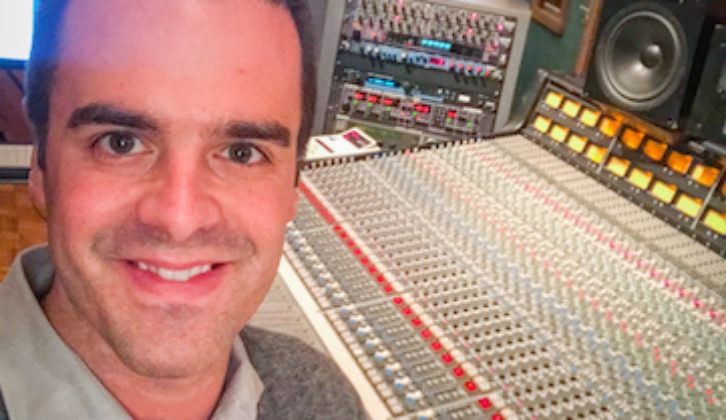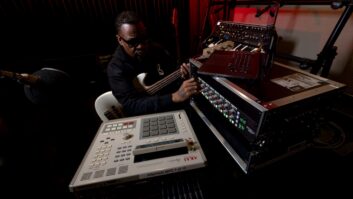
What’s in a name? For Annie Lennox, Stevie Wonder, John Legend, Gladys Knight, Barry Manilow, Idina Menzel, John Mayer, Sia, Dionne Warwick, James Taylor, Bette Midler, Adam Lambert, Cyndi Lauper, Peter Frampton, Andrea Bocelli, Melissa Etheridge, Paul Shaffer, Jordin Sparks, Micky Dolenz, Alanis Morrissette, and Josh Groban it’s musical prowess. And for Michael J. Moritz, Jr., it’s music production.
Over the past six months, Moritz—an Emmy and Tony Award-winning producer/record producer/music supervisor/music director/arranger/Broadway music supervisor/performer/pianist who specializes in the pop and musical theater genres—has worked remotely with all of those names in music (and many more) to create benefit concerts and fundraising variety shows to raise money for organizations like UNICEF and the CDC.
“Back in late March, my good friend and music direction client Erich Bergen (Jersey Boys, Madam Secretary) asked me to consult and produce on a huge undertaking— a starry ‘virtual Passover Seder’ variety special,” Moritz says. “In pre-Covid life, Erich and I have toured the country with his solo show and with countless notable orchestras, including the Boston Pops.” In the weeks that followed, Moritz would continue to work in collaboration with actor-turned-live-event producer Bergen.
Saturday Night Seder (which raised $3 million for the CDC) was a big YouTube streaming event with more than 50 celebrities partaking in an online Seder celebration with comedy and music. “The opening number was this theatrical wonderland that went from celeb to celeb to celeb to celeb. It was Jason Alexander, Darren Criss, Josh Groban, Rachel Brosnahan, and so on,” he explains. “We had a full band, a full brass section, reeds, strings… it was a full complement of instrumentation and all of these people. This project is where I figured out this process of remote production.”
Setting Up for Remote Production
Moritz was no stranger to working with top-notch music talent pre-pandemic. For instance, he produced the charity single “What the World Needs Now” sung by Broadway For Orlando (a group of esteemed pop and theater performers like Idina Menzel, Gloria Estefan, Matthew Broderick and Kristen Bell, who came together in support of the victims of the Orlando nightclub shooting in 2016), and served as conductor, music director and producer for both From Broadway With Love: A Benefit Concert for Orlando and From Broadway With Love: A Benefit Concert for Parkland.
Moritz’s 2019 Tony Award was for Best Musical as a co-producer of Hadestown. And he earned two Tony and Olivier Award nominations as a co-producer for Broadway/West End’s Beautiful: The Carole King Musical and On The Town. Other notable Broadway producing credits include Big Fish, A Night With Janis Joplin and The Velocity of Autumn.
However, Moritz feels that his recent experience in remote production has been singularly satisfying. “I’m not a ‘star-struck’ person, but getting to work with all of these people in the total upper echelon of the music industry has been really inspiring because they want to participate; they care about a cause,” says Moritz. “They don’t need to stay relevant or tour right now. They’re doing these shows because they care. They put in the time and trust the people who are putting the programs together. And at the end of it, it’s to raise money. It’s been a much more altruistic time for music and for me.”
When the pandemic closed studio doors (temporarily) in New York City, Moritz grabbed some essential gear and headed to his hometown of Youngstown, Ohio—where he previously owned a commercial recording studio and video sound stage and still owns a commercial music store. He set up a makeshift studio in his rental home but quickly realized it would need some serious upgrades. One huge disadvantage was a lack of acoustic treatment.

“I scrambled to figure out how to do some absorption and diffusion in a way that wouldn’t wreck our home and turn our living space into something totally different,” he says. “I found Overtone Acoustics. They make great acoustic panels, but they do something I’ve never seen before—they can print directly on the fabric. I worked with them to put together a treatment solution that solved my acoustic problems, but it also blends into our space in an unobtrusive way. They just look like great art.”
For studio monitors, Moritz picked up a pair of Eve Audio SC307s to replace his Mackie HR824 pair. The SC307 three-way speakers feature ribbon tweeters “that keep me glued to the mix room. With the ribbon tweeters, I can mix way longer than I should be mixing per day,” he says.
Moritz uses Metric Halo’s ULN-2 3d audio interface, which he says “is great for when we do live capture because there’s a MADI card option on the 3d that does copper MADI or optical MADI,” he explains. “When I do live capture, triple redundancy is the standard. I have the 4x copper MADI, so I can get two output splits from that and the third can go through MADI, or Dante, or AVB, depending on what’s going on.”
Other outboard gear includes the McDSP 16-channel Analog Processing Box and two UAD-2 Satellite plug-in boxes (OCTO model). Moritz feeds everything into Steinberg’s Nuendo running on a 2017 iMac loaded with RAM. He says, “I’ve been using Nuendo for over 15 years. I’ve found it to be unparalleled. It’s so intuitive. With the visibility agents in the mix window, I really don’t find myself reaching for a traditional controller so much, like my Avid S3.”
Instead, he uses a set of small-format controllers—an Elgato Stream Deck programmed with macro shortcuts and a Loupedeck CT controller for left-handed work. “Loupedeck isn’t known in the audio world—I found them through a colorist friend—but the controller has a jog wheel and a bunch of OLED screens on it, and everything locks the application in focus,” he says.
Musicians Unite
Since that initial remote production on Saturday Night Seder, Moritz has been perfecting his workflow on a string of star-studded, music-based streaming events, from UNICEF’s We Won’t Stop on MSNBC to People Magazine’s Carousel of Hope Ball fundraiser in October. “It’s almost unthinkable that in the last six months I’ve done over 100 recordings,” he says. “Every week to week-and-a-half, I’m doing a one-hour show with my very small audio team, which sounds unreal. How is that even possible? It’s just not a normal time!”
Each project presented unique challenges. For Annie Lennox’s performance in the UNICEF concert, Moritz had one mixed track with her vocals and piano. He says, “I distinctly remember on that one thinking, ‘How can I clear out the room, but also, from a single-source recording, maybe impart some reverb onto her voice but keep the piano dry?’ I played with iZotope’s Music Rebalance and essentially extracted her vocal and then used that vocal to feed a reverb at 100 percent wet, and then re-incorporated it. You just have to work with what you have.”
Moritz did a mix for Stevie Wonder for another benefit concert. “Stevie was using great mics, but on his recording I had to edit out quite a bit of wind because he was outside because of the pandemic! There was also a harpist in the song who performed in a super-live room so I had to claw out the real signal from all the room reverb,” he says.
For the Carousel of Hope Ball, Moritz and his team are doing a remake of “That’s What Friends Are For.” They recorded Gladys Knight at home, and then Dionne Warwick at home. “The trick was, if we were going to capture these recordings in less-than-ideal rooms, how do we make the mix better?” he explains. “One solution is to find one source with great fidelity to lend to a project. I knew we had to get mics and legit setups on the band because that fidelity would help to make the track sound better overall.
“You have to lean into what you get, lean into the things that, if you tried to remove them, would cause you problems at every step of the way,” he adds. “You have to listen with the mindset of ‘What is this for? What do the other mics that I’m ingesting sound like in this package? How can I get the recordings to sound close to one another, sonically and acoustically? And, how do I keep them to the highest fidelity without imparting artifacts?’ It’s all about trying to remove as much room as you can to get a realistic-sounding, dry take.”

For UNICEF’s event, Moritz did a world-meets-pop-music re-orchestration of Whitney Houston’s “Higher Love,” performed by Jordin Sparks. Moritz created a guide/framework track in Nuendo and sent that via Dropbox to his drummer, guitarist, bassist, and rhythm section. He imported their parts back into his master session and created a rough mix with guide tracks for a 60-member gospel choir. Each singer in the choir recorded a cell phone video of him/herself singing and sent that back to Moritz. He separated the audio from the video, imported the .wav files into iZotope RX8 for cleanup, exported those into Nuendo, synched them up, and created a new mix for Sparks to perform to.
“Then I mailed a USB mic to Jordin and she sang her part in her closet while I produced her vocals over Zoom,” he says.
Moritz used a similar workflow on a track he produced for The International Thespian Festival, which featured 150 singers, and for a track he did with Barry Manilow singing “One Voice,” which had 120 singers. He says, “Every one of those phone submissions had problems sonically. But after some light cleaning on the tracks, using Spectral De-noise and Spectral Recovery in iZotope RX, and some light cleaning on the bus-level, it sounds quite passable when you join them altogether. I think there’s a great advantage to the power of numbers.”
Mixing From a Variety of Sources
Synching up 100 different vocal tracks recorded in different locations on different mics and making it sound like a chorus of people singing together seems daunting. At least, it should. For Moritz, the solution is to “work directly in Nuendo’s native audiowarp tools for pitch and timing correction, and also use Synchro Arts’ ReVoice Pro to help lock together problematic takes from different sources. I like to tune modestly, and tighten performances so all the cutoffs are right, the entrances are right, and all the sibilance are exactly in line,” he explains.
Mixing music (even when it’s turning iPhone recordings into polished tracks) isn’t the main challenge for Moritz. His real challenge was, as a music professional, diving into the sound-for picture world. Moritz has been actively seeking out post sound solutions, like ReVoice Pro, which haven’t shown up on his radar before.
He says, “For Saturday Night Seder, they brought me on to produce and mix all of the music numbers and I ended up also mixing the dialog. I’m like a re-recording mixer now, too. I’ve found Nugen Audio’s plug-ins—like ISL and LM-Correct—to be incredibly helpful for achieving consistency from segment to segment across a one-hour show, and for staying within broadcast or network spec. You can manually watch meters, but once you get the mix close, these plug-ins essentially do the QC for you on the way up, so I know loudness compliance won’t hurt me.”
In the role of music supervisor, Moritz is responsible for putting together all the prep materials, from creating a boilerplate with instructions on how to submit tracks to setting up file request links via Dropbox. He also creates and exports guide tracks for each performer. Oftentimes, he’s creating new arrangements of songs or different orchestrations.
It requires clear pre-planning and rigorous organizational practices, like using consistent file naming conventions to easily find and organize files within smart folders in macOS. With hundreds of files moving from the talent to Moritz to the video and audio teams and back again, keeping track of everything is essential. “That’s the secret,” he says. “So much of it is being organized and having good email follow-through, and funneling things into a really good organizational system that you can track and audit.”
‘I’ve been enjoying helping other people to figure out how to adapt to the new challenges of production. There are a lot of lessons in this for people who do pre-pro at home or do self-release albums from home.’
After Saturday Night Seder, several major broadcast companies and producers for Late Night shows and even high-profile podcasts reached out to Moritz to ask about his process of remote production.
“I’ve ended up consulting for them, to help them find better ways and new workflows,” he says. “I’ve been enjoying helping other people to figure out how to adapt to the new challenges of production. There are a lot of lessons in this for people who do pre-pro at home or do self-release albums from home. Look at the Billie Eilish record. That all happened in a bedroom.
“Knowledge will always trump gear, and kindness and patience will always trump ego,” he says in summary. “I’ve always loved the work, and my passion has never diminished. However, using talent and resources to help effect change in the world and to raise up marginalized communities, as well as sharing my knowledge to encourage younger talents in our business, brings a sense of pride far greater than any stream counts, social media metrics, and download numbers could ever bring.”







